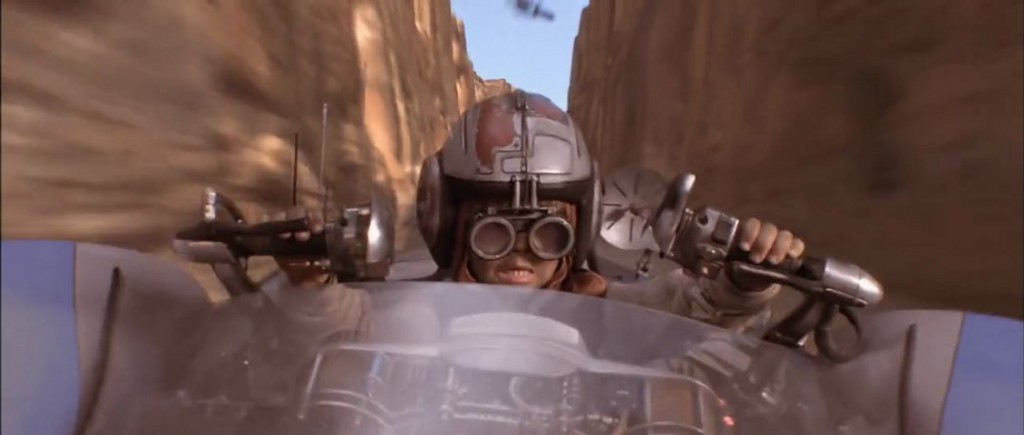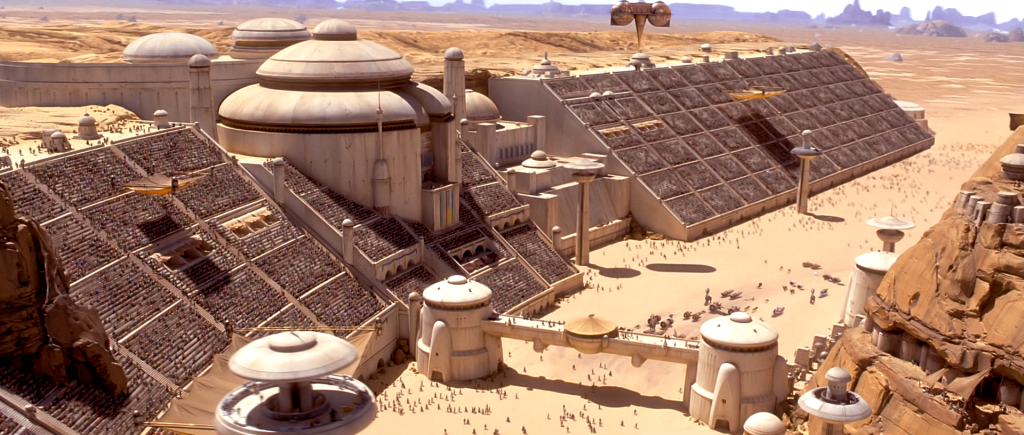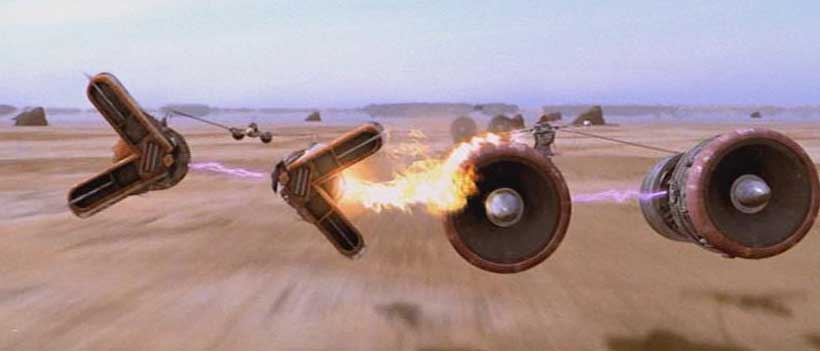In honor of the year 2015, the year Star Wars returns to theaters, I’ll be writing a series of articles throughout the year to celebrate (and occasionally eviscerate), the greatest franchise ever. Enjoy! And may Christmas 2015 come faster than it takes Han Solo to do the Kessel Run.
The year was 1999. For movie nerds, that year marked the arrival of the single most anticipated film in movie history. It was the year The Phantom Menace came out. As millions of Star Wars fans left their local theater confused about how the magic of Star Wars could disappear faster than a womp rat on meth, I went back to my apartment looking for answers. Did George Lucas really just turn my favorite franchise into a bad Saturday morning cartoon?
In the time since, a lot has been dedicated to explaining why the movie didn’t work. But one of the things that doesn’t get mentioned that often – if it all – is the featured set-piece in the movie: the Pod Race.
The Pod Race, in George Lucas’s mind, WAS the movie. While good ole George was excitedly grinding everything from characters to sets into his digital blender, the Pod Race was the one thing he actually built stuff for. Every one of the vehicles in that race was a real prop.
So why is it, then, that a set-piece given so much attention, given so much screen time, given so much weight in the film, turned out to be one of the most boring races (and set-pieces) ever put on film? You watch that race and you’re not focusing on whether Anakin is going to win or not. You focus on why everything is so fucking boring.
The answer to this – once learned – will ensure that you never write a bad set-piece again (or at least one as bad as this). To be honest, set-pieces are typically one of the more boring parts of a screenplay. They’re often cut-and-dry “car speeds up, cuts other car off, joey shoots, brad ducks” blueprint-oriented scenes, rather than scenes written to actually evoke emotion (huge mistake). Truth be told, a lot of execs skim over set-pieces because there’s no important story information in them and it allows them to finish the read quicker.
If you’re doing your job, a reader will never EVER want to skim past a scene. They’ll be so caught up in your characters and your story that every little moment in that set-piece matters to them! So what did screenwriter George Lucas do so terribly to make this sequence, which should’ve been one of the classic all-time action scenes, so boring? Five things, to be exact. Let’s take a look at them.
“BORING MAIN CHARACTER” – I honestly don’t care if you’re the greatest set-piece writer in the world. If we don’t care about the person who’s at the center of the set piece, nothing you write in the set-piece will matter. I say this again and again on the site, but writers never do anything about it! Stop putting all your time into the set-piece and put it into creating an original, compelling, entertaining main character who we want to root for. Star Wars could’ve turned The Pod Race into a Bobbing For Apples contest and it would’ve worked if we cared about Anakin.
“NO MAIN CHARACTER FLAW” – In my newsletter, I talked about the importance of dealing with your characters’ internal issues in external ways. There’s no better time to do this than in a set-piece. And there’s no better way to explore it than through your hero’s unique flaw. If you’re going to build a ten minute race scene into your movie, it better challenge your hero’s flaw in some way. The problem here? Annakin didn’t have a flaw. He had some doubts, some fears. But he didn’t have a clear flaw. In contrast, Luke Skywalker didn’t fully believe in himself. That was his flaw. And that’s why him trusting himself in that ending Death Star sequence was so goose-bump inducing. A clear character flaw equals clear “external conflict” to play with during set-pieces, which creates a closer emotional connection between movie and viewer.
“THE BULLSHIT ARTIST” – Set pieces are your movie’s big performance numbers. In an action movie, they will often be what your movie is remembered for. So their reason for existing has to be airtight. The Rebels didn’t attack the Death Star in the first Star Wars, for example, because someone had a hunch that the base had a weakness. They had the Death Star plans that told them exactly how to destroy the base. In The Phantom Menace, we’re sold some cheap B.S. that winning this pod race (and using the prize money to fix their broken ship) was the only way for our group to get off the planet. As if two of the most important Jedi in the galaxy couldn’t have found an alternative way to leave. Once we know you’re trying to bullshit us on the reasoning for a set-piece’s existence, we turn on you quickly.
“OVER-COMPLICATION” – One of the things I continue to see amateur writers do wrong is needlessly overcomplicate their stories. Stop. Just stop! There’s always a simpler way. What you do when you over-complicate something, is you create confusion in the reader. If the reader is confused about why a big set-piece is going on, nothing in the set-piece matters. Before the Pod Race, Lucas injects an incredibly complicated bet between Qui-Gon and a local alien gambler that states if Anakin loses, the alien gets the pod-racer, but if Qui-Gon wins, he gets the pod racer, Anakin, and a part for his broken ship. The alien then doubles down, and if he wins, he gets the ship, the pod racer, the Anakin, and possibly Qui-Gon too. Qui-Gon comes back at him and doubles his own bet by asking for Anakin’s mom if they win as well. It’s so needlessly confusing, that by the time the race starts, we’re clueless as to what needs to happen. Confusion is NEVER EVER EVER good for your story and is especially bad right before a major sequence.
“REPETITION” – A set-pieces’ mortal enemy is repetition. If the cars that are chasing each other are doing the same dance for too long or if the bad guys and the good guys continue to shoot and duck in the same way over and over, we’re going to lose interest. A set-piece is a mini-movie. And just like any movie, you need to challenge and surprise your audience over and over again. Treat your set-piece like your portfolio and diversify. In the Pod Race, we were subjected to the same desert checkpoints again and again with little variety in the action or interactions between racers.
To me, the worst set-pieces are the ones that feel too technical. A set-piece is a complex series of organisms that have to work together. It’s great if you’ve come up with an imaginative set-piece. But if your hero isn’t battling his flaw as well (i.e. Neo fighting Smith in the subway when he didn’t believe in himself yet), then the set-piece feels empty. You might have the coolest location for your set-piece ever, but if you don’t establish big stakes and make those stakes CLEAR, we’re going to be confused about why the set-piece is happening (i.e. the race car set-piece in Iron Man 2).
Learn why the Pod Race, and other set-pieces like it, aren’t working, so that when it comes time to write your own set-piece, you’ll be ready to deliver.




